Barcelona Demos and Motherboards
Much to our dismay and definitely against our recommendations, AMD will not follow in Intel's footsteps and let us do a performance preview of Agena or Barcelona. In fact, AMD wouldn't even let us know what clock speeds its demo systems were running at. While we cautioned AMD that a lack of information disclosure at this point would only reinforce this idea that AMD is lagging far behind Intel, AMD's counterpoint does have some validity. AMD's reasoning for not disclosing more information today has to do with not wanting to show all of its cards up front, and to give Intel the opportunity to react. We still don't believe it's the right decision, and we can't help but believe that the reason for not disclosing performance today is because performance isn't where it needs to be, but only AMD knows for sure at this point.
In order to combat worries that Barcelona is fundamentally broken, AMD did give us a couple of live demos of an 8-core QuadFX system and a 4-core Socket-AM2+ system. AMD ran Cinebench as well as Nero Recode on the systems, but it did not let us measure performance on either. Both systems worked fine; they didn't get too hot and they didn't crash.
Undoubtedly Agena and Agena FX work. We suspect that clock speeds aren't quite as high as they need to be but we don't doubt that AMD can get there by its scheduled release sometime in the second half of this year.
AMD also let us get up close and personal with the motherboards used in these systems, but we can't disclose details about the chipsets used just yet. Keep in mind that what you're looking at is AMD's next-generation desktop chipset solution.
The Hammerhead reference board is AMD's Socket-AM2+ reference board that was used in the quad-core Agena system above:
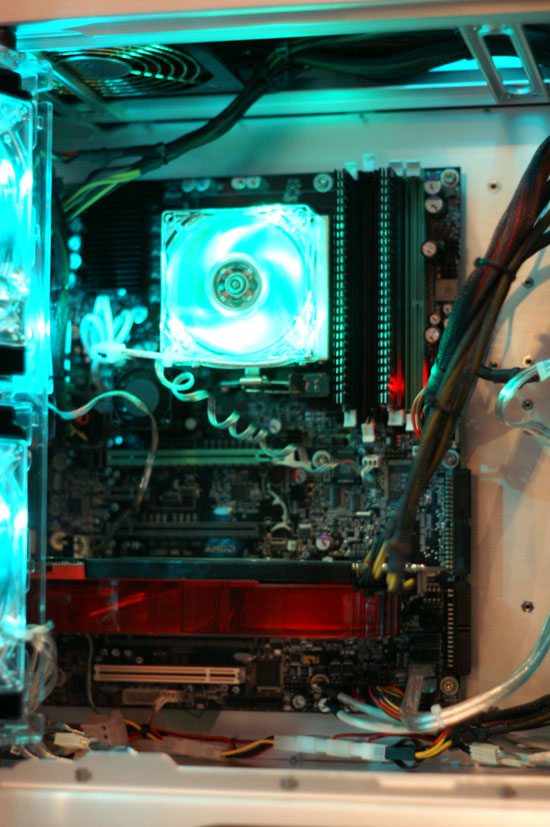
Up and running
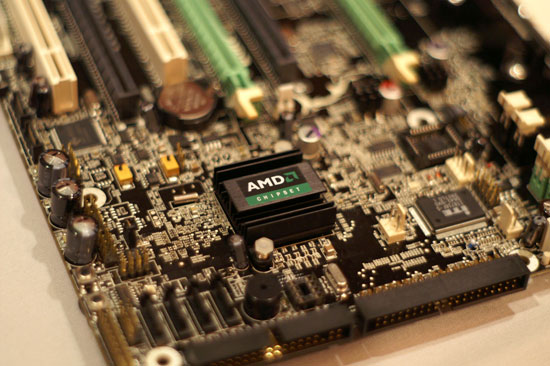
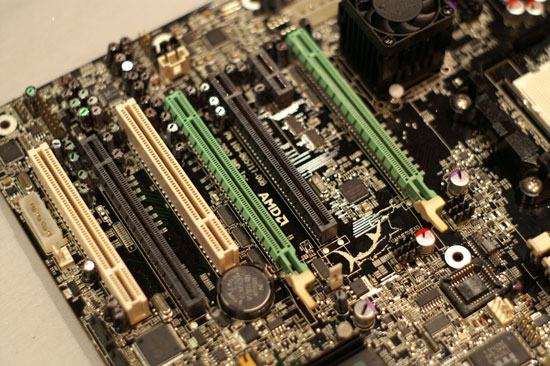
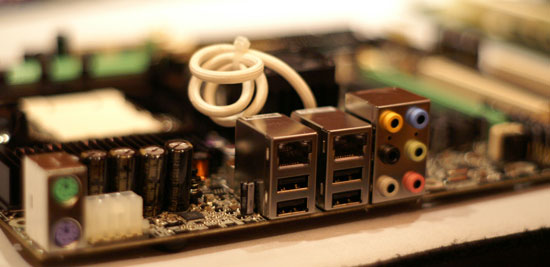
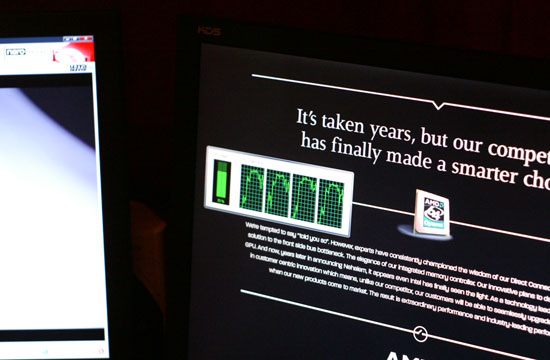
All four cores, loaded and running
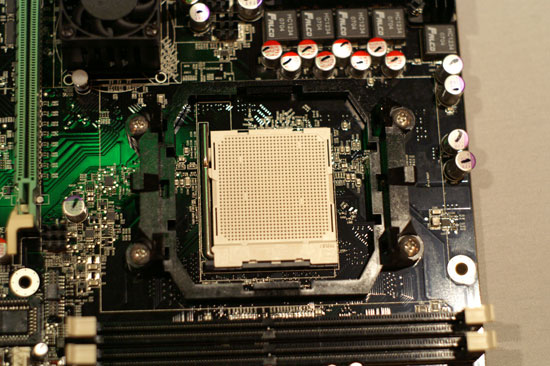
Socket-AM2+
The Wahoo reference board is AMD's QuadFX Socket-1207+ reference board, used in the eight-core Agena FX system:
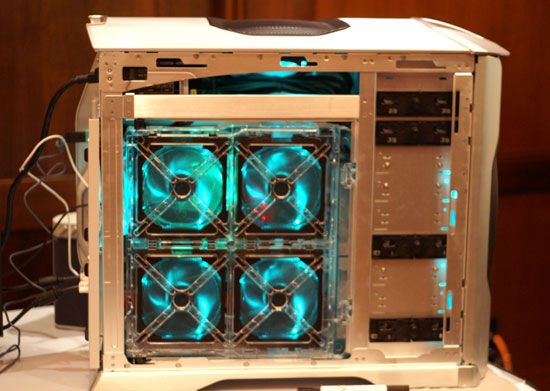

Quad core per socket x two sockets
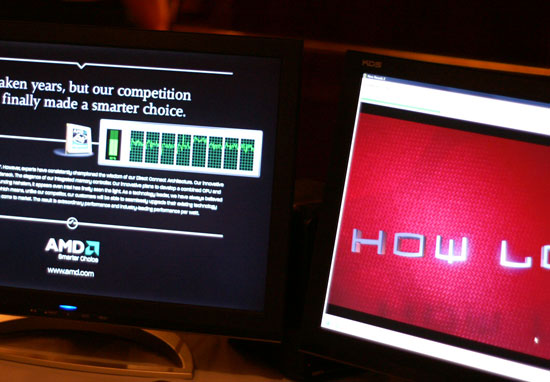
All eight cores, locked and loaded
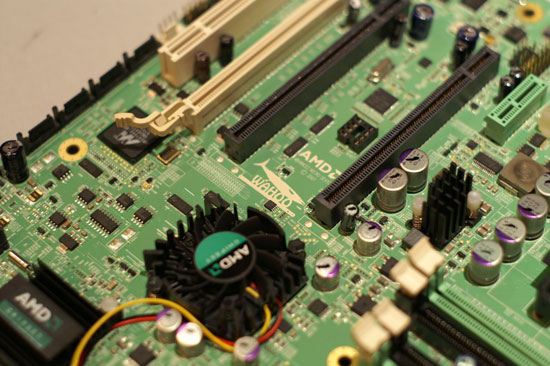
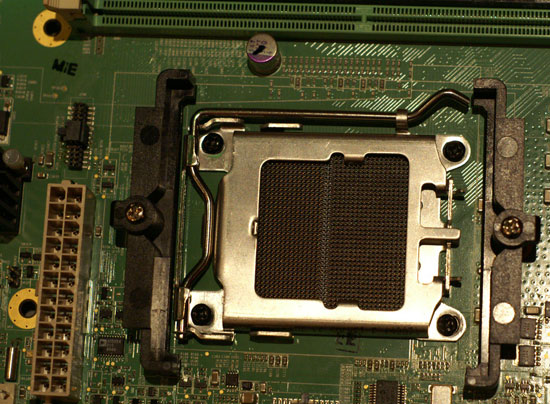
Socket-1207+
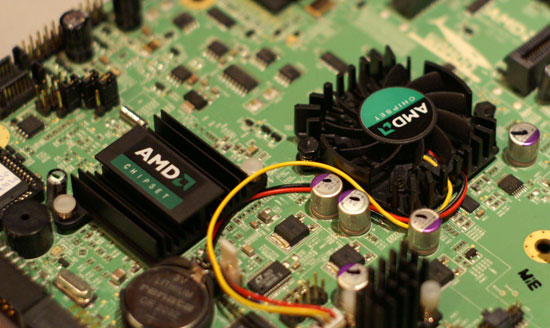
And here's the man that made sure we could see these demos - AMD's Ian McNaughton:

He's also the guy that prevented us from running benchmarks, and hid the Cinebench scores from us:

Much to our dismay and definitely against our recommendations, AMD will not follow in Intel's footsteps and let us do a performance preview of Agena or Barcelona. In fact, AMD wouldn't even let us know what clock speeds its demo systems were running at. While we cautioned AMD that a lack of information disclosure at this point would only reinforce this idea that AMD is lagging far behind Intel, AMD's counterpoint does have some validity. AMD's reasoning for not disclosing more information today has to do with not wanting to show all of its cards up front, and to give Intel the opportunity to react. We still don't believe it's the right decision, and we can't help but believe that the reason for not disclosing performance today is because performance isn't where it needs to be, but only AMD knows for sure at this point.
In order to combat worries that Barcelona is fundamentally broken, AMD did give us a couple of live demos of an 8-core QuadFX system and a 4-core Socket-AM2+ system. AMD ran Cinebench as well as Nero Recode on the systems, but it did not let us measure performance on either. Both systems worked fine; they didn't get too hot and they didn't crash.
Undoubtedly Agena and Agena FX work. We suspect that clock speeds aren't quite as high as they need to be but we don't doubt that AMD can get there by its scheduled release sometime in the second half of this year.
AMD also let us get up close and personal with the motherboards used in these systems, but we can't disclose details about the chipsets used just yet. Keep in mind that what you're looking at is AMD's next-generation desktop chipset solution.
The Hammerhead reference board is AMD's Socket-AM2+ reference board that was used in the quad-core Agena system above:

Up and running
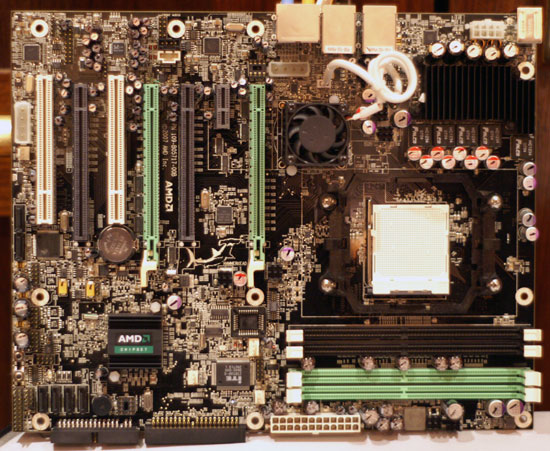 |
| The motherboard - Click to Enlarge |




All four cores, loaded and running

Socket-AM2+
The Wahoo reference board is AMD's QuadFX Socket-1207+ reference board, used in the eight-core Agena FX system:


Quad core per socket x two sockets

All eight cores, locked and loaded
 |
| The Wahoo Motherboard - Click to Enlarge |


Socket-1207+

And here's the man that made sure we could see these demos - AMD's Ian McNaughton:

He's also the guy that prevented us from running benchmarks, and hid the Cinebench scores from us:











55 Comments
View All Comments
Regs - Friday, May 11, 2007 - link
Tight lipped does make AMD look bad right now but could be even worse for them after Intel has their way with the information alone. I'm not talking about technology or performance, I'm talking about marketing and pure buisness politics.Intel beat AMD to market by a huge margin and I think it would be insane for AMD to go ahead and post numbers and specifications while Intel has more than enough time to make whatever AMD is offering look bad before it hits the shelves or comes into contact with a Dell machine.
strikeback03 - Friday, May 11, 2007 - link
Intel cut the price of all the C2D processors by one slot in the tree - the Q6600 to the former price of the E6700, the E6700 to the former price of the E6600, the E6600 to the former price of the E6400, etc. Anandtech covered this a month or so ago after AMD cut prices.
I wonder as well. Will it be relatively easy to mix and match features as needed? Or will the offerings be laid out that most people end up paying for a feature they don't want for each feature they do?
yyrkoon - Friday, May 11, 2007 - link
Yeah, its hard to take this peice of 'information' without a grain of salt added. On one hand you have the good side, true integrated graphics (not this shitty thing of the past, hopefully . . .), with full bus speed communication, and whatnot, but on the other hand, you cut out discrete manufactuers like nVidia, which in the long run, we are not only talking about just discrete graphics cards, but also one of the best/competing chipset makers out there.
Regs - Friday, May 11, 2007 - link
The new attitude Anand displays with AMD is more than enough and likely the whole point of the article.AMD is changing for a more aggressive stance. Something they should of done years ago.
Stablecannon - Friday, May 11, 2007 - link
Aggressive? I'm sorry could you refer me to the article that gave you that idea. I must have missed while I was at work.
Regs - Friday, May 11, 2007 - link
Did you skim?There were at least two whole paragraphs. Though I hate to qoute so much content, I guess it's needed.
sprockkets - Friday, May 11, 2007 - link
What is there that is getting anyone excited to upgrade to a new system? We need faster processors and GPUs? Sure, so we can play better games. That's it?Now we can do HD content. I would be much more excited about that except it is encumbered to the bone by DRM.
I just wish we had a competent processor that only needs a heatsink to be cooled.
Not sure what you are saying since over a year ago they would have been demoing perhaps 65nm cells, but whatever.
And as far as Intel reacting, they are already on overdrive with their product releases, FSB bumps, updating the CPU architecture every 2 years instead of 3, new chipsets every 6 months, etc. I guess when you told people we would have 10ghz Pentium 4's and lost your creditbility, you need to make up for it somehow.
Then again, if AMD shows off benchmarks, what good would it do? The desktop varients we can buy are many months away.
Viditor - Saturday, May 12, 2007 - link
In April of 2006, AMD demonstrated 45nm SRAM. This was 3 months after Intel did the same...
sprockkets - Friday, May 11, 2007 - link
To reply to myself, perhaps the Fusion project is the best thing coming. If we can have a standard set of instructions for cpu and gpu, we will no longer need video drivers, and perhaps we can have a set that works very low power. THAT, is what I want.Wish they talked more of DTX.
TA152H - Friday, May 11, 2007 - link
I agree with you about only needing a heat sink, I still use Pentium IIIs in most of my machines for exactly that reason. I also prefer slotted processors to the lame socketed ones, but they cost more and are unnecessary so I guess they aren't going to come back. They are so much easier to work with though.I wish AMD or Intel would come out with something running around 1.4 GHz that used 10 watts or less. I bought a VIA running at 800 MHz a few years ago, but it is incredibly slow. You're better off with a K6-III+ system, you get better performance and about the same power use. Still, it looks like Intel and AMD are blind to this market, or minimally myopic, so it looks like VIA/Centaur is the best hope there. The part I don't get is why they superpipeline something for high clock speed when they are going for low power. It seems to me an upgraded K6-III would be better at something like this, since by comparison the Pentium/Athlon/Core lines offer poor performance for the power compared to the K6 line, considering it's made on old lithography. So does the VIA, and that's what it's designed for. I don't get it. Maybe AMD should bring it back as their ultra-low power design. Actually, maybe they are. On a platform with reasonable memory bandwidth, it could be a real winner.